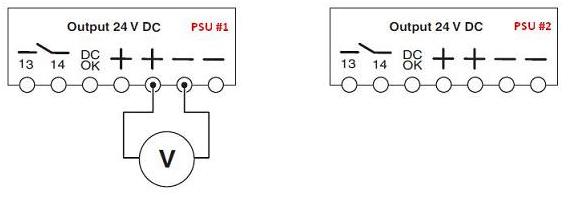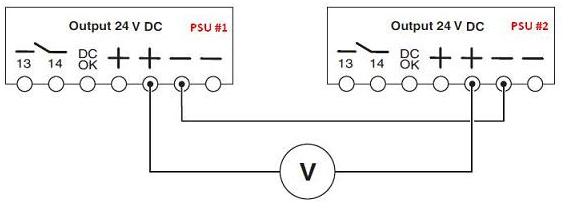Voltage balancing is a process where total power is distributed uniformly onto the single units in a typical power redundancy system. In actuality, performing voltage balancing on 2 power supply units is not difficult. If you follow the 3 simple steps (as shown below), you can be assured that the total power supply will be distributed as uniformly as possible onto individual units.
It is also important to note before we get started that only specifically designed power supply units (for example, Phoenix Contact QUINT SFB power supplies) can be connected in parallel.
STEP 1:
You will need to gather the tools you need for voltage balancing. Namely, you need a digital multimeter (for example, Phoenix Contact TESTFOX M-1) to measure the output voltage, and a Philips screw driver to adjust the potentiometer.
STEP 2:
Once you have all the tools ready, you will first start by powering up the 1st power supply unit at no-load mode. Adjust the desired output voltage (for example, 24VDC) via the potentiometer using a multimeter. See the diagram below.
STEP 3:
Next, connect the 2nd power supply to the 1st power supply and the multimeter as shown in the diagram below. Both power supplies unit are in operation and at no-load mode. Balancing of the power supply units is carried out by means of differential voltage measurement. For this, the output voltage of the 2nd power supply is adjusted using the potentiometer until the multimeter no longer measures any voltage. Both output voltages are exactly set if the differential voltage between both power supply units is 0 V. The lower the differential voltage of the power supply units, the more symmetrical the distribution of the total current for the 2 single units.
If you still have additional question, please drop me an email.





hi wats your myspace page
Even with the voltage balacened, it still does not gaurantee taht the load shared by the two power supplies in parallel is equal. This is because of internal resistance of the power supplies. The higher the difference in internal resistance the greater is the difference in the load sharing. The reason is when you start loading the power supplies due to internal resistance the terminal voltage drops. With different internal resistance, the terminal voltage of the two will be different. Since it cannot be different as they are connected in parallel, the load shared will be different so that the terminal voltage of the two supplies is same.
Thank you for your interest in the voltage balancing topic.
You are right that is not easy to achieve 50-50% load sharing between 2 power supply units that are connected in parallel. Apart from the resistance factor which you had mentioned, it is also important to note that the symmetrical values of the cross section and length of the cables should be the same. In addition, the operating temperature of each power supply may have an influence on the load sharing and therefore, it highly recommended to install the power supply units next to each other.
Do you have an application which you needs to ensure that the power supply units share the load symmetrically? If yes, I will be very happy to discuss this topic further with you.